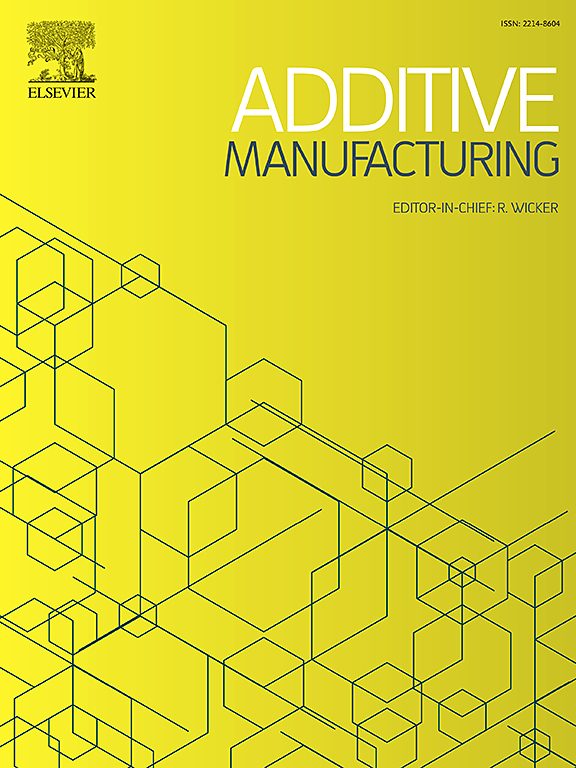Impact of droplet oxidation on mechanical properties of an Al-7Si-0.4Mg alloy fabricated with liquid metal jetting
IF 10.3
1区 工程技术
Q1 ENGINEERING, MANUFACTURING
引用次数: 0
Abstract
Droplet-on-demand liquid metal jetting (DOD-LMJ) is a new method for additive manufacturing of bulk structural alloys. Here, we report on the microstructure, tensile, and fatigue properties of an Al-7Si-0.4Mg (A356) alloy fabricated with LMJ. Liquid metal droplets were shielded by high-purity Ar gas shroud during deposition. Atom probe tomography revealed that a few nanometers thick (Al-Mg-Si)-O oxide film formed on the droplets despite Ar gas shielding. Tensile tests on peak-aged LMJ A356 alloy showed that yield strength was isotropic (250 MPa), but ductility was lower in the build direction (6.1 ± 1.4 %) compared to the transverse direction (9.4 ± 1.0 %). Lower ductility in the build direction was attributed to delamination of metal-oxide interfaces at layer boundaries. The ductility and yield strength of LMJ A356 were similar to cast A356 and laser powder bed fused (LPBF) A357 alloys, indicating the limited impact of oxide film on tensile properties. The oxide film severely impacted the fatigue properties. Fatigue resistance of LMJ A356 was limited by fatigue crack initiation at lack-of-fusion defects and fatigue crack propagation along layer boundaries by delamination of the metal-oxide interface. The fatigue strength of LMJ A356 at 60 MPa was lower than cast A356 and LPBF A357 alloys in the peak-aged condition. This research underscores the need for managing droplet oxidation during LMJ additive manufacturing of structural alloys.
液滴氧化对液态金属喷射制造的 Al-7Si-0.4Mg 合金机械性能的影响
按需液态金属喷射(DOD-LMJ)是一种用于大块结构合金增材制造的新方法。在此,我们报告了使用 LMJ 制造的 Al-7Si-0.4Mg (A356) 合金的微观结构、拉伸和疲劳性能。在沉积过程中,液态金属液滴被高纯度氩气护罩屏蔽。原子探针断层扫描显示,尽管有氩气保护,液滴上仍形成了几纳米厚的 (Al-Mg-Si)-O 氧化膜。对峰值老化的 LMJ A356 合金进行的拉伸试验表明,屈服强度是各向同性的(250 兆帕),但与横向(9.4 ± 1.0 %)相比,构建方向的延展性较低(6.1 ± 1.4 %)。构建方向的延展性较低是由于层边界的金属-氧化物界面分层造成的。LMJ A356 的延展性和屈服强度与铸造 A356 和激光粉末床熔化 (LPBF) A357 合金相似,表明氧化膜对拉伸性能的影响有限。氧化膜严重影响了疲劳性能。LMJ A356 的抗疲劳性能受限于融合缺失缺陷处的疲劳裂纹起始以及金属-氧化物界面分层导致的疲劳裂纹沿层界扩展。在峰值时效条件下,LMJ A356 在 60 兆帕时的疲劳强度低于铸造 A356 和 LPBF A357 合金。这项研究强调了在 LMJ 结构合金增材制造过程中管理液滴氧化的必要性。
本文章由计算机程序翻译,如有差异,请以英文原文为准。
求助全文
约1分钟内获得全文
求助全文
来源期刊

Additive manufacturing
Materials Science-General Materials Science
CiteScore
19.80
自引率
12.70%
发文量
648
审稿时长
35 days
期刊介绍:
Additive Manufacturing stands as a peer-reviewed journal dedicated to delivering high-quality research papers and reviews in the field of additive manufacturing, serving both academia and industry leaders. The journal's objective is to recognize the innovative essence of additive manufacturing and its diverse applications, providing a comprehensive overview of current developments and future prospects.
The transformative potential of additive manufacturing technologies in product design and manufacturing is poised to disrupt traditional approaches. In response to this paradigm shift, a distinctive and comprehensive publication outlet was essential. Additive Manufacturing fulfills this need, offering a platform for engineers, materials scientists, and practitioners across academia and various industries to document and share innovations in these evolving technologies.
 求助内容:
求助内容: 应助结果提醒方式:
应助结果提醒方式:


